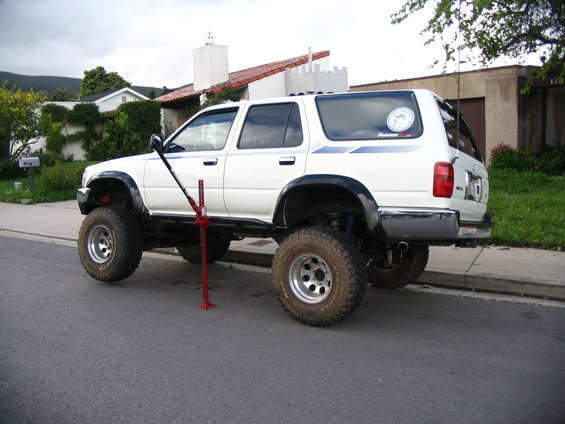The Supra also traces much of its roots back to the Toyota 2000GT with the main instance being its engine. The first three generations were offered with a direct descendant to the Toyota Crown's and 2000GT's M engine. All four generations of Supra produced have an inline 6-cylinder engine. Interior aspects were also similar, as was the chassis code "A".

Toyota Truck Lift Kit 1986-95

1993 Toyota 4Runner \x26quot;yota\x26quot;
Along with this name and car Toyota also included its own logo for the Supra. It is derived from the original Celica logo, being blue instead of orange. This logo was used until January 1986, when the Mark III Supra was introduced. The new logo was similar in size, with orange writing on a red background, but without the dragon design. That logo, in turn, was on Supras until 1991 when Toyota switched to its current oval company logo. (the dragon logo was a Celica logo regardless of what color it was. It appeared on the first two generations of the Supra because they were officially Toyota Celicas. The dragon logo was used for the Celica line until it too was discontinued.)

Year/Model: 1993 Toyota
In 1998, Toyota ceased sales of the Supra in the United States and in 2002 Toyota officially stopped production of the Supra in Japan.

Nick\x26#39;s 1993 Toyota 4Runner
As an iconic sports car, the Supra has appeared in numerous video games, movies, music videos and TV shows. Some of the most notable appearances include the Gran Turismo, Forza Motorsport, Need for Speed, and Midnight Club series of video games and the 2001 film, The Fast and the Furious.

Year/Model: 1993 Toyota

1993 Toyota 4Runner - Columbus
1,988 cc (1.988 L; 121.3 cu in) M-EU I6 1,988 cc (1.988 L; 121.3 cu in) M-TEU I6 2,563 cc (2.563 L; 156.4 cu in) 4M-E I6

West_Texas_QB\x26#39;s 1993 Toyota

1993 Toyota 4Runner Pro Comp

1993 Toyota 4Runner Pro Comp
The first generation Supra was based largely upon the Toyota Celica liftback, but was longer by 129.5 mm (5.10 in). The doors and rear section were shared with the Celica but the front panels were elongated to accommodate the Inline-6 instead of the stock Celica's 4-cylinder engine. Toyota's original plan for the Supra at this time was to make it a competitor to the very popular Datsun (now Nissan) Z-car.

BLrunningbacks 1993 Toyota

1990-1995 Toyota 4Runner
In April 1978 Toyota began production of the Mark I Supra in Japan, as the Toyota Celica XX. It debuted in the United States in Jan 1979. The USA Mark I (chassis code MA46) was originally equipped with a 110 hp (82 kW) 2,563 cc (2.563 L; 156.4 cu in) 12-valve SOHC inline-6 engine (4M-E). In April 1978, the Japanese Mark I (chassis code MA45) was offered with a 110 hp (82 kW) 2.0 L 12-valve SOHC inline-6 engine (M-EU). The Japanese Supra was equipped with the smaller 2.0 L engine so that buyers wouldn't incur an additional tax under vehicle size and engine displacement regulations. Both were equipped with electronic fuel injection.

Steve\x26#39;s 1993 Toyota Pickup

1993 Toyota 4Runner SR5

1993 Toyota 4Runner Hi Lift

Year/Model: 1993 Toyota

4runner/4rgs.jpg

Toyota Truck Lift Kit 1986-95

1993 Toyota 4Runner \x26quot;yota\x26quot;
Along with this name and car Toyota also included its own logo for the Supra. It is derived from the original Celica logo, being blue instead of orange. This logo was used until January 1986, when the Mark III Supra was introduced. The new logo was similar in size, with orange writing on a red background, but without the dragon design. That logo, in turn, was on Supras until 1991 when Toyota switched to its current oval company logo. (the dragon logo was a Celica logo regardless of what color it was. It appeared on the first two generations of the Supra because they were officially Toyota Celicas. The dragon logo was used for the Celica line until it too was discontinued.)

Year/Model: 1993 Toyota
In 1998, Toyota ceased sales of the Supra in the United States and in 2002 Toyota officially stopped production of the Supra in Japan.

Nick\x26#39;s 1993 Toyota 4Runner
As an iconic sports car, the Supra has appeared in numerous video games, movies, music videos and TV shows. Some of the most notable appearances include the Gran Turismo, Forza Motorsport, Need for Speed, and Midnight Club series of video games and the 2001 film, The Fast and the Furious.

Year/Model: 1993 Toyota

1993 Toyota 4Runner - Columbus
1,988 cc (1.988 L; 121.3 cu in) M-EU I6 1,988 cc (1.988 L; 121.3 cu in) M-TEU I6 2,563 cc (2.563 L; 156.4 cu in) 4M-E I6

West_Texas_QB\x26#39;s 1993 Toyota

1993 Toyota 4Runner Pro Comp

1993 Toyota 4Runner Pro Comp
The first generation Supra was based largely upon the Toyota Celica liftback, but was longer by 129.5 mm (5.10 in). The doors and rear section were shared with the Celica but the front panels were elongated to accommodate the Inline-6 instead of the stock Celica's 4-cylinder engine. Toyota's original plan for the Supra at this time was to make it a competitor to the very popular Datsun (now Nissan) Z-car.

BLrunningbacks 1993 Toyota

1990-1995 Toyota 4Runner
In April 1978 Toyota began production of the Mark I Supra in Japan, as the Toyota Celica XX. It debuted in the United States in Jan 1979. The USA Mark I (chassis code MA46) was originally equipped with a 110 hp (82 kW) 2,563 cc (2.563 L; 156.4 cu in) 12-valve SOHC inline-6 engine (4M-E). In April 1978, the Japanese Mark I (chassis code MA45) was offered with a 110 hp (82 kW) 2.0 L 12-valve SOHC inline-6 engine (M-EU). The Japanese Supra was equipped with the smaller 2.0 L engine so that buyers wouldn't incur an additional tax under vehicle size and engine displacement regulations. Both were equipped with electronic fuel injection.

Steve\x26#39;s 1993 Toyota Pickup

1993 Toyota 4Runner SR5

1993 Toyota 4Runner Hi Lift

Year/Model: 1993 Toyota

4runner/4rgs.jpg
No comments:
Post a Comment